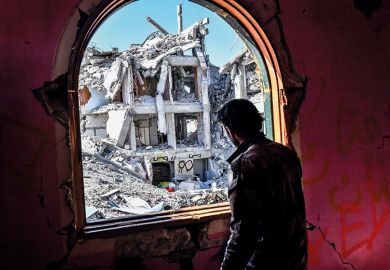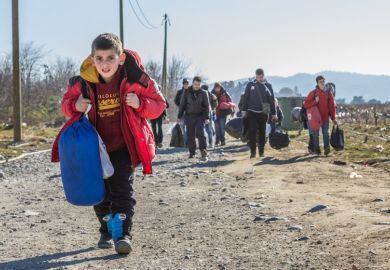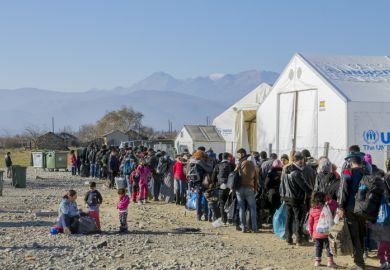The Syrian refugee crisis has raised major questions about how Europe as a whole, and the individual countries within the continent, can cope with a humanitarian disaster on its doorstep. Many of those who did manage to escape from war zones and find safety were students keen to complete or further their studies. Yet such refugees often arrive with inadequate language skills for degree-level courses in a foreign country and qualifications that are non-transferable or poorly documented. Many have also lived through terrible events and carry a severe burden of trauma.
All this inevitably presented a number of specific challenges for governments and universities. Much of the burden fell on Turkey, home to more than 3.5 million Syrian refugees in 2018.
Ayselin Yildiz, Unesco chair on international migration at Yasar University in Izmir, notes that “Turkey currently hosts nearly 28,000 Syrian students in its universities. This is 17 per cent of all international students and 3 per cent of all registered students”. This has proved possible because the country “responded to the mass inflow from Syria quickly in 2012 by offering special status to Syrian students, which means they are eligible to attend [preparatory] courses at Turkish universities”. Also crucial has been a “‘transfer procedure’ for students who have had to interrupt their education due to violent events and humanitarian crises in Syria, Egypt and Yemen”, she says. Students who were enrolled at university before the 2013-14 academic year are offered direct access to proceed with their higher education as transfer students in Turkey, she explains.
One of the most prominent institutions in refugee education in Turkey is the University of Gaziantep, which “realised that there are thousands of youngsters waiting to be university students”, according to Nur Incetahtaci, who works in the international relations office and is one of the speakers at tomorrow’s session on “Integrating Syrian refugees into higher education systems: a success story” at the European Association for International Education conference.
In response to the demand, Dr Incetahtaci says that the university “opened Arabic programmes, translated our curricula into Arabic, trained Syrian professors, appointed Turkish professors as coordinators and opened five academic programmes in Arabic”, on which about 460 students enrolled. The first cohort graduated this year.
The university also introduced a number of programmes to promote “integration and inclusion”, says Dr Incetahtaci, as well as some devoted to “the empowerment of the refugee students” through “entrepreneurship, civic engagement, basic life skills and legal issues”. By the 2018-19 academic year, 2,300 of Gaziantep’s 3,800 registered international students were Syrian, with the most popular disciplines being medicine, civil engineering and architecture.
One can find similar initiatives to meet the needs of refugee students right across Europe. The European University Association has been very active in this field, through initiatives such as its Refugees Welcome Map and its inHERE programme devoted to “higher education supporting refugees in Europe”. Outputs of the latter include the association’s Guidelines for University Staff Members, featuring a self-assessment tool; inspiring examples of good practice; and minimum-, medium- and maximum-level suggestions for how universities should address the needs of refugee students.
Alongside longer-term strategic planning and the basic questions of access around admission, financial support, recognition and preparatory courses, these guidelines also consider academic and social integration, psychological support and career guidance.
On the tricky issue of refugee students who lack documentation, the Guidelines propose as a minimum that universities “provide information about the procedure for the verification and recognition of previous qualifications”. Yet it is better if the institutions themselves “take care of the verification and recognition of refugees’ previous qualifications” by using external services – and better still if institutions have “dedicated internal resources” for this task, the Guidelines advise.
Given that refugees can be “an especially vulnerable group, due to previous stressful events and the hurdles of starting a new life”, the Guidelines suggest that institutions should at least “provide information on where to seek psychological support outside the university”, yet they should also consider giving access to “free psychological support provided by students of [the] Psychology Department” or, better still, “free professional support by university scholars and/or…external associations”.
Some national organisations have also been proactive in supporting refugee students.
Germany was famously “generous” in accepting large numbers of refugees at the height of the crisis. The German Academic Exchange Service, according to Christian Hülshörster, head of division for Scholarships South, has “supported all kinds of language and foundation courses, tutoring programmes and assessment tests in order to better integrate refugee students at German HEIs”. It has also “sponsored a large number of students from Syria with a special scholarship programme – ‘Leadership for Syria’ – to come to Germany – 221 in total,” he says.
On the ground at Goethe University Frankfurt, according to Julia Jochim, project coordinator of the Academic Welcome Program (AWP), they take in about 50 refugees per term. Those who undertake formal studies (data protection rules mean that the numbers are not available) have to deal with a number of challenges, which the university is trying to address.
As for the social aspects of university life, reports Ms Jochim, “some former AWP participants have told us that it is difficult to meet and develop friendships with German and other students”, although they are also “afraid to always be seen as refugees”. The AWP and international office have tried to “facilitate such social contact” through “buddy programmes”.
Even more fundamental for refugee integration are questions of finance. Although most refugees are theoretically eligible for government student loans in Germany, explains Ms Jochim, some do not receive them because “they have previously studied in their home country and have now changed study course or due to age limits”. The restricted number of scholarships available tend to require high grades, which are difficult for refugees to attain. The AWP therefore “helps refugees both with [student loans] and scholarship applications to increase their chances”. Meanwhile, the university is “looking for external sponsors who would be willing to provide scholarships for talented refugees”, although this has not always proved easy.
In Norway, too, both official agencies and universities are working to remove the obstacles that can block the progress of refugee students.
In 2015, the Norwegian Agency for Quality Assurance in Education joined forces with the UK National Recognition Information Centre to pilot the Qualifications Passport for Refugees as “a multinational framework to organise and establish a fast-track scheme to evaluate refugees’ educational and training background while still ensuring their mobility”. It has since been rolled out in many European countries and may eventually become a global scheme. Norway also hosted the initial consortium meeting that led to the creation of the Toolkit for Recognition for Refugees – an agreed upon recognition system for refugees’ qualifications.
Such frameworks are clearly essential, but what lessons have individual Norwegian universities learned through trying to integrate Syrian and other refugee students?
In autumn 2015, amid harrowing stories of people drowning in the Mediterranean, Petter Ottersen, rector of the University of Oslo, and then chairman of the Norwegian Association of Higher Education Institutions, issued a call for an academic dugnad (a Norse word for good deed) to help alleviate the situation. The university has gone on to take in about 10 per cent of the national total of Syrian refugee students, although numbers remain small. Anna K. Buverud, senior adviser in the university’s department of research administration, has a number of observations that may be useful far beyond Oslo and even Norway.
It is very important for countries, for example, to provide “updated and relevant information and guidance on how to enter or continue higher education”, she says. Admissions requirements and higher education systems are varied and complex, so “potential students with a refugee background may well feel that they are being discriminated against even when this is not the case”.
In general, Ms Buverud goes on, “HE solutions for refugees should not be developed for refugees only”. Other migrants, “late bloomers” and people wanting to acquire new skills later in life often have similar needs, so “allowing all on to the same track is likely to reduce xenophobia as well as reduce the ‘refugee label stigma’ that many with a refugee background struggle with”.
Being aware of refugees’ particular mental health needs has also been integral to successfully hosting them on campus. Although Ms Buverud acknowledges that “access to higher education may reduce the risk of trauma-related mental illness”, this is not always the case and universities should not assume that students will flourish just because they have apparently got their life back on track. Indeed, “such illnesses may hit just when everything is falling into place, because the brain then finally lowers its guard after months or years of high stress levels, according to psychologists we have discussed this with”.
No matter the initial responses from their national governments to the refugee crisis and the subsequent public opinion about the influx, universities have been at the forefront of integrating displaced students and, largely through trial and error, have now acquired a good deal of wisdom about effective ways of doing so. Sharing such wisdom can only benefit them and their students.
Register to continue
Why register?
- Registration is free and only takes a moment
- Once registered, you can read 3 articles a month
- Sign up for our newsletter
Subscribe
Or subscribe for unlimited access to:
- Unlimited access to news, views, insights & reviews
- Digital editions
- Digital access to THE’s university and college rankings analysis
Already registered or a current subscriber?




